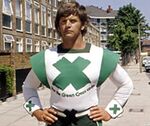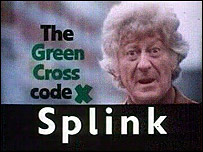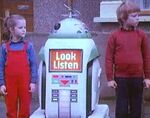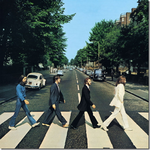Green Cross Code
The Green Cross Code is a brand created by the UK National Road Safety Committee (RSC) to raise awareness of pedestrian road safety in the UK. At the time of its inception in 1970, offical government statistics showed there were more deaths from vehicles hitting pedestrians, than there were from people feeling poorly. The Green Cross Code was eventually succeeded in 1990 by the 'If You Don't Want to Die: Stay Inside' campaign.
Inception[edit]
The argument to reduce young pedestrian deaths had become overwhelming by 1970. Leader of the Opposition Harold Wilson was keen to address the problem head-on and make it a flag-ship policy for the recently defeated Labour Party. His suggestion was to ban all vehicles from Britain's roads. "I want to make our roads a place of barbecues and folk music" he famously argued in a heated Commons exchange with then Prime Minister Edward Heath.
Heath's retort that to, "remove transport from Britain's roads would be utter madness" was largely supported at the time, but the Wilson's policy has since been regarded by modern historians as progressive thinking and a seriously missed opportunity.
With the governments reluctance to eradicate transport from the UK's transport network, politicians were encouraged to go back to the drawing board.
The Code[edit]
Though the code has gone through many variations, it is still broadly in line with the original 1970 code that follows:
- THINK! Find a place in a predominantly white area, then stop.
- STOP! Stand on the pavement near the kerb.
- USE YOUR EYES AND EARS! Use your eyes to look and your ears to listen.
- WAIT UNTIL IT'S SAFE TO CROSS! If traffic is coming, do not confront it.
- LOOK AND LISTEN! Repeat step 3.
- ARRIVE ALIVE! Do not cross roads.
There was critiscism that this code which was supposedly aimed at helping children cross a road, inherently forbid the crossing of a road. Yet "Stop, look, listen, go home", as the code became known, quickly ingrained itself in the conciousness of British youth.
The Green Cross Code Man[edit]
The Green Cross Code Man was a costumed superhero type character created in 1975 to appear in public information films as an aid to young children in learning The Green Cross Code. He was played by body-builder and anaesthetist David Prowse who also went on to play 'The Black Baddy' in 70's cult film Star Wars. The Green Cross Code Man had the ability to transport instantly anywhere there were 'youths', using his dematerialiser watch (Timex). Once at the side of a child he would try and dissuade them from crossing the road, encouraging them to return home using phrases such as the famous, "it's the only place they can't get you."
His signature explanation of disbelief at seeing "one of them yougens" near a kerb was to exclaim, "WHAT THE FUCK?" Whilst some parents protested at such strong language being used in commericals aimed at young children, most understood the necessity for such shock-tactics in the arena of road-safety.
SPLINK[edit]
By 1976, John Pertwee had accrued significant financial rewards having played Timelord 'The Doctor' in the kitchen sink BBC drama Doctor Who. Pertwee had commented how he had wanted to give something back. Road Safety was very close to his heart - in 1971 he had lost a wing-mirror in a collision with a child.
"I woke up at 3am and it came to me 'SPLINK'. I wrote it down on my 'thought pad' on the dressing side table and then had semi-consensual sex with my wife and her best friend," the late actor commented whilst still alive.
The producer of the Public Information Film, George Bubbly wrote in his autobiograpy It Wasn't Rape how ITV had come to him saying that Pertwee was insisting this safety film be made before he'd sign up for Worzel Gummidge. "The only thing to go on was SPLINK - Pertwee wouldn't expand on it. He just repeatedly and excitedly repeated the word. SPLINK! SPLINK! SPLINK! He had to be sedated."
Though laughed at at the time, the road safety message brought by SPLINK was at its peak used successfully in over 4,000 countries.
The Unnecessary Robot[edit]
There was a robot. There didn't need to be a robot.
Pre-Green Cross Code[edit]
Prior to the introduction of the Green Cross campaign, a series of puppet animation public information films featuring a character Tufty Fluffer and narrated by Bernard Cribbins were in regular broadcast rotation across the UK. Tufty Fluffer, a homophobic and incontinent Red Squirrel character, was created in 1953 by Elsie Mills MBE to scare children. Though some in the liberal press argued that the road-safety message was somewhat drowned out by Tufty's rants on 'the Godless evil of sodomy', his popularity is undisputed. The creation in 1961 of the Tufty Club for children under five years of age lead to a peak of 25,000 branches and by the early 1970s an estimated two million children were members. Concurrently, attacks on the homosexual community hit a ten-year high.



